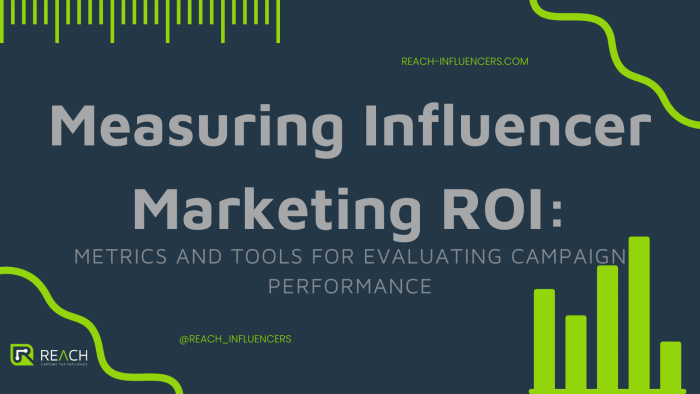Influencer Marketing Metrics: diving into the essential data that drives successful influencer campaigns. From tracking engagement to measuring conversions, this topic is where it’s at.
Get ready to explore the ins and outs of how brands leverage influencer marketing metrics to boost their online presence and connect with their target audience.
Overview of Influencer Marketing Metrics
Influencer marketing metrics are key indicators used to measure the success and effectiveness of influencer marketing campaigns. These metrics provide valuable insights into the performance of a campaign, helping brands understand the impact of their collaborations with influencers.Unlike traditional marketing metrics, influencer marketing metrics focus on specific aspects such as engagement, reach, and audience demographics. These metrics take into account the unique nature of influencer partnerships and the dynamics of social media platforms.
Popular Influencer Marketing Metrics
- Follower Count: The number of followers an influencer has on a particular platform, indicating their potential reach.
- Engagement Rate: The level of interaction (likes, comments, shares) the influencer’s content receives from their audience.
- Click-Through Rate (CTR): The percentage of clicks on a link included in the influencer’s post, showing the effectiveness of driving traffic.
- Conversion Rate: The percentage of followers who take a desired action, such as making a purchase or signing up for a newsletter.
- Brand Mentions: The frequency and sentiment of mentions of the brand or product in the influencer’s content.
Types of Influencer Marketing Metrics

In influencer marketing, various metrics are used to measure the success and impact of campaigns. Each type of metric provides valuable insights into different aspects of the campaign performance.
Engagement Metrics
Engagement metrics measure how audiences interact with influencer content. This includes likes, comments, shares, and overall engagement rate. Brands use engagement metrics to gauge the level of audience interest and the effectiveness of the content in driving interactions.
- Number of likes, comments, and shares on posts
- Engagement rate (total engagement divided by total followers)
Reach Metrics
Reach metrics focus on the number of people who see the influencer’s content. This includes impressions, views, and overall reach. Brands use reach metrics to understand the potential exposure of their campaigns to a wider audience.
- Total impressions or views of influencer content
- Reach rate (total reach divided by total followers)
Conversions Metrics
Conversions metrics measure the actions taken by the audience after viewing influencer content. This includes clicks, website visits, sign-ups, purchases, and overall conversion rate. Brands use conversions metrics to track the impact of influencer campaigns on driving desired actions.
- Click-through rate (CTR)
- Conversion rate (total conversions divided by total clicks)
Key Performance Indicators (KPIs) in Influencer Marketing

When it comes to influencer marketing, tracking Key Performance Indicators (KPIs) is crucial for brands to measure the success of their campaigns. KPIs help in setting specific goals, tracking progress, and ultimately determining the impact of influencer collaborations.
Essential KPIs for Influencer Campaigns
- Engagement Rate: This KPI measures the level of interaction and engagement generated by the influencer’s content. It includes likes, comments, shares, and saves on the post.
- Reach: The reach KPI determines the total number of people who have seen the influencer’s content. It helps in assessing the overall exposure of the campaign.
- Conversion Rate: This KPI tracks the percentage of viewers who took the desired action after seeing the influencer’s content, such as making a purchase or signing up for a newsletter.
Role of KPIs in Campaign Success
- KPIs provide measurable metrics that allow brands to set specific targets and objectives for their influencer campaigns.
- By tracking KPIs, brands can monitor the progress of their campaigns in real-time and make necessary adjustments to optimize performance.
- Using KPIs, brands can evaluate the effectiveness of influencer collaborations and determine the ROI of their marketing efforts.
Examples of KPI-Driven Campaigns
- Brand X saw a 20% increase in online sales after partnering with an influencer who had a high conversion rate, showcasing the impact of tracking this KPI.
- Company Y’s engagement rate doubled after implementing a campaign with an influencer who resonated well with their target audience, highlighting the importance of monitoring engagement as a KPI.
Tools and Platforms for Measuring Influencer Marketing Metrics
When it comes to tracking and analyzing influencer marketing metrics, brands have a variety of tools and platforms at their disposal. These tools help brands make data-driven decisions to optimize their influencer marketing campaigns and ensure they are getting the best ROI.
Popular Tools for Measuring Influencer Marketing Metrics
- 1. Socialbakers: Socialbakers provides in-depth analytics and reporting on influencer campaigns, helping brands measure engagement, reach, and conversions.
- 2. Hootsuite: Hootsuite offers social media management tools that include influencer tracking and performance measurement features.
- 3. Upfluence: Upfluence is an influencer marketing platform that helps brands identify, manage, and track influencers, as well as measure campaign performance.
Comparing Tools for Measuring Influencer Marketing Metrics
- Socialbakers: Known for its comprehensive analytics and reporting capabilities, but can be complex for beginners.
- Hootsuite: Great for overall social media management, but may lack advanced influencer marketing-specific features.
- Upfluence: Offers a user-friendly interface and robust influencer tracking tools, but may be more expensive for smaller brands.
Insights into Using Tools for Influencer Marketing Metrics
By utilizing these tools, brands can track the performance of their influencer campaigns, measure key metrics like engagement and conversions, and make informed decisions to optimize their strategies for better results.





